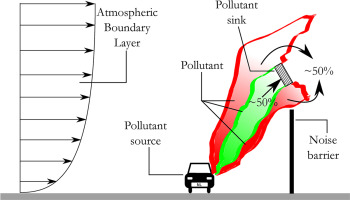当前位置:
X-MOL 学术
›
Atmos. Environ.
›
论文详情
Our official English website, www.x-mol.net, welcomes your feedback! (Note: you will need to create a separate account there.)
Air pollutant sinks on noise barriers: Where do they perform the best?
Atmospheric Environment ( IF 5 ) Pub Date : 2018-08-01 , DOI: 10.1016/j.atmosenv.2018.05.041 Amitosh Dash , Gerrit E. Elsinga
Atmospheric Environment ( IF 5 ) Pub Date : 2018-08-01 , DOI: 10.1016/j.atmosenv.2018.05.041 Amitosh Dash , Gerrit E. Elsinga

|
Abstract While laboratory experiments, numerical simulations as well as field tests have underlined the influence of noise barriers in dispersing vehicular emissions and reducing downwind peak concentrations, these pollutants still remain in the atmosphere. Artificial pollutant sinks (for example, particle capturing or toxic gas treating devices) installed on top of noise barriers can further alleviate this problem by eliminating the pollutants passing through it. However, it is not known how the installation of a semi-permeable pollutant sink affects the aerodynamics of the pollutants' flow. By finding an optimal position and orientation for these sinks, the mass of the pollutants reaching the sink inlet can be maximized. Scaled down water tunnel experiments have been used to investigate the effectiveness of installing such a pollutant sink, of fixed dimensions, on top of a noise barrier adjacent to a highway. It is found that installing a sink is more beneficial on top of shorter barriers and that vertically elevating the sink, only slightly, can enhance its pollutant capturing performance. Using a sink in a ‘highway canyon’ (two noise barriers placed symmetrically with respect to the highway) must be done cautiously as there are several flow regimes observed, which are sensitive not only to the canyon aspect ratio (ratio between canyon width and height), but also to the presence/absence of the sink. The results here not only demonstrate the effectiveness of installing pollutant sinks on noise barriers, but also provide ballpark estimates on the optimal placement, orientation and performance of these devices, prior to field tests or even large-scale installation.
中文翻译:

空气污染物沉在隔音屏障上:它们在哪里表现最好?
摘要 虽然实验室实验、数值模拟和现场测试都强调了隔音屏障在分散车辆排放和降低顺风峰值浓度方面的影响,但这些污染物仍然存在于大气中。安装在隔音屏障顶部的人工污染物汇(例如,颗粒捕获或有毒气体处理装置)可以通过消除通过它的污染物来进一步缓解这个问题。然而,目前尚不清楚安装半渗透污染物汇如何影响污染物流动的空气动力学。通过为这些汇找到最佳位置和方向,可以最大化到达汇入口的污染物质量。已使用按比例缩小的水隧道实验来研究安装此类污染物汇的有效性,固定尺寸,位于高速公路附近的隔音屏障顶部。研究发现,在较短的障碍物顶部安装水槽更有利,垂直提升水槽,只需稍微提升,就可以提高其污染物捕获性能。在“高速公路峡谷”(相对于高速公路对称放置的两个隔音屏障)中使用水槽必须谨慎,因为观察到的几种流态不仅对峡谷纵横比(峡谷宽度和高度之间的比率)敏感),但也与水槽的存在/不存在有关。这里的结果不仅证明了在隔音屏障上安装污染物汇的有效性,而且在现场测试甚至大规模安装之前,还提供了对这些设备的最佳放置、方向和性能的大致估计。在高速公路附近的隔音屏障顶部。研究发现,在较短的障碍物顶部安装水槽更有利,垂直提升水槽,只需稍微提升,就可以提高其污染物捕获性能。在“高速公路峡谷”(相对于高速公路对称放置的两个隔音屏障)中使用水槽必须谨慎,因为观察到的几种流态不仅对峡谷纵横比(峡谷宽度和高度之间的比率)敏感),但也与水槽的存在/不存在有关。这里的结果不仅证明了在隔音屏障上安装污染物汇的有效性,而且在现场测试甚至大规模安装之前,还提供了对这些设备的最佳放置、方向和性能的大致估计。在高速公路附近的隔音屏障顶部。研究发现,在较短的障碍物顶部安装水槽更有利,垂直提升水槽,只需稍微提升,就可以提高其污染物捕获性能。在“高速公路峡谷”(相对于高速公路对称放置的两个隔音屏障)中使用水槽必须谨慎,因为观察到的几种流态不仅对峡谷纵横比(峡谷宽度和高度之间的比率)敏感),但也与水槽的存在/不存在有关。这里的结果不仅证明了在隔音屏障上安装污染物汇的有效性,而且在现场测试甚至大规模安装之前,还提供了对这些设备的最佳放置、方向和性能的大致估计。
更新日期:2018-08-01
中文翻译:

空气污染物沉在隔音屏障上:它们在哪里表现最好?
摘要 虽然实验室实验、数值模拟和现场测试都强调了隔音屏障在分散车辆排放和降低顺风峰值浓度方面的影响,但这些污染物仍然存在于大气中。安装在隔音屏障顶部的人工污染物汇(例如,颗粒捕获或有毒气体处理装置)可以通过消除通过它的污染物来进一步缓解这个问题。然而,目前尚不清楚安装半渗透污染物汇如何影响污染物流动的空气动力学。通过为这些汇找到最佳位置和方向,可以最大化到达汇入口的污染物质量。已使用按比例缩小的水隧道实验来研究安装此类污染物汇的有效性,固定尺寸,位于高速公路附近的隔音屏障顶部。研究发现,在较短的障碍物顶部安装水槽更有利,垂直提升水槽,只需稍微提升,就可以提高其污染物捕获性能。在“高速公路峡谷”(相对于高速公路对称放置的两个隔音屏障)中使用水槽必须谨慎,因为观察到的几种流态不仅对峡谷纵横比(峡谷宽度和高度之间的比率)敏感),但也与水槽的存在/不存在有关。这里的结果不仅证明了在隔音屏障上安装污染物汇的有效性,而且在现场测试甚至大规模安装之前,还提供了对这些设备的最佳放置、方向和性能的大致估计。在高速公路附近的隔音屏障顶部。研究发现,在较短的障碍物顶部安装水槽更有利,垂直提升水槽,只需稍微提升,就可以提高其污染物捕获性能。在“高速公路峡谷”(相对于高速公路对称放置的两个隔音屏障)中使用水槽必须谨慎,因为观察到的几种流态不仅对峡谷纵横比(峡谷宽度和高度之间的比率)敏感),但也与水槽的存在/不存在有关。这里的结果不仅证明了在隔音屏障上安装污染物汇的有效性,而且在现场测试甚至大规模安装之前,还提供了对这些设备的最佳放置、方向和性能的大致估计。在高速公路附近的隔音屏障顶部。研究发现,在较短的障碍物顶部安装水槽更有利,垂直提升水槽,只需稍微提升,就可以提高其污染物捕获性能。在“高速公路峡谷”(相对于高速公路对称放置的两个隔音屏障)中使用水槽必须谨慎,因为观察到的几种流态不仅对峡谷纵横比(峡谷宽度和高度之间的比率)敏感),但也与水槽的存在/不存在有关。这里的结果不仅证明了在隔音屏障上安装污染物汇的有效性,而且在现场测试甚至大规模安装之前,还提供了对这些设备的最佳放置、方向和性能的大致估计。


























 京公网安备 11010802027423号
京公网安备 11010802027423号